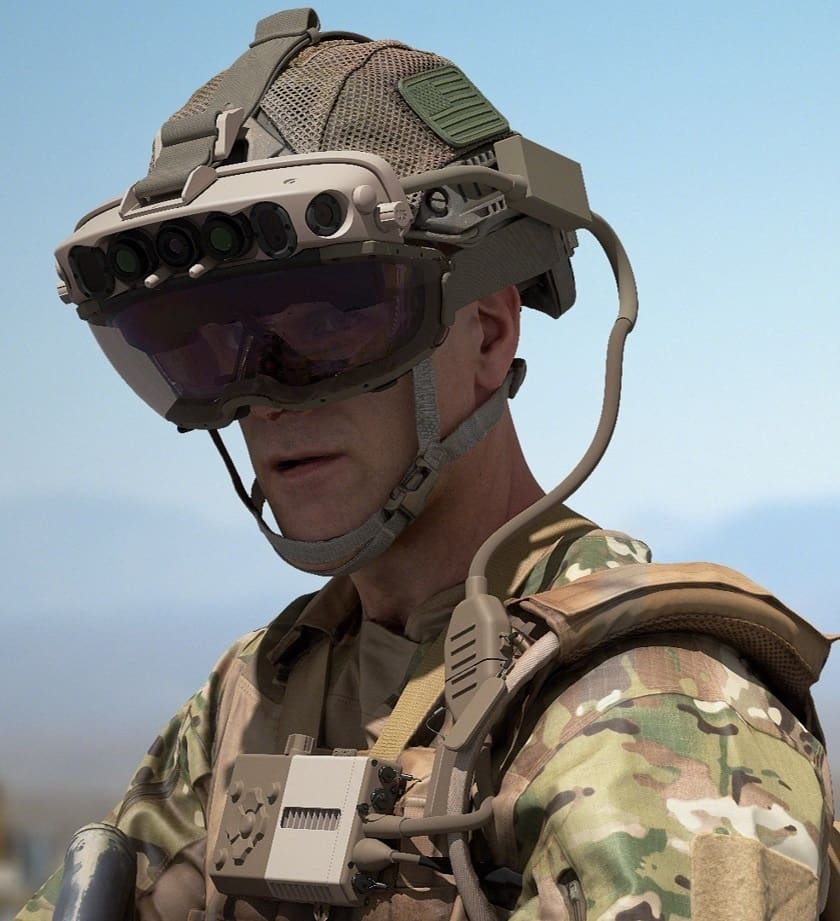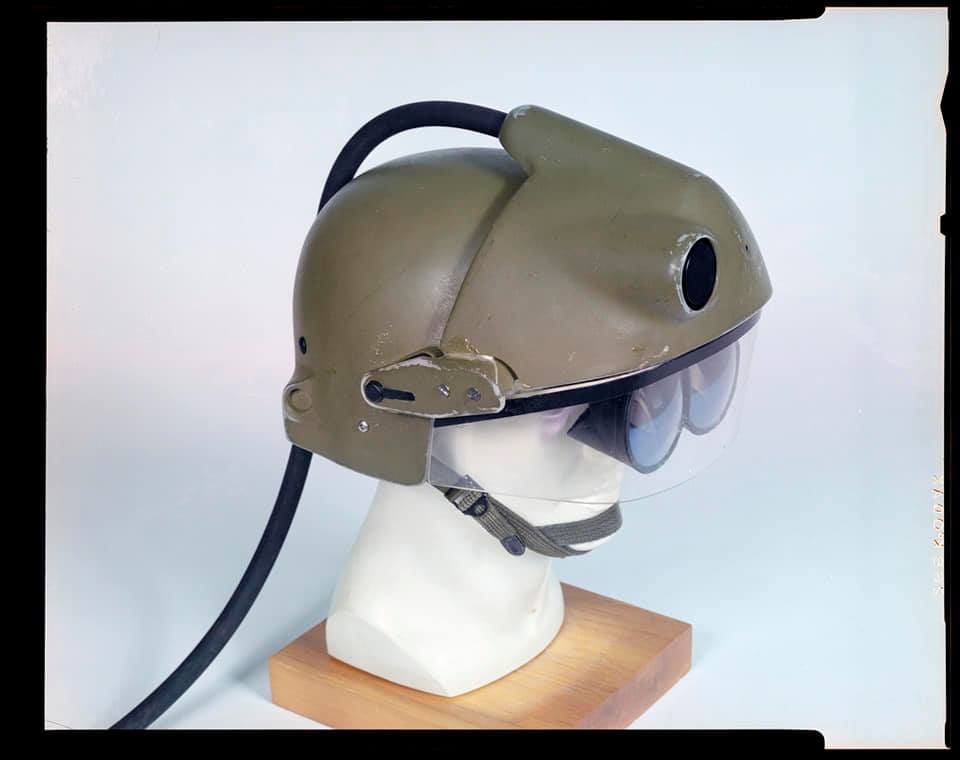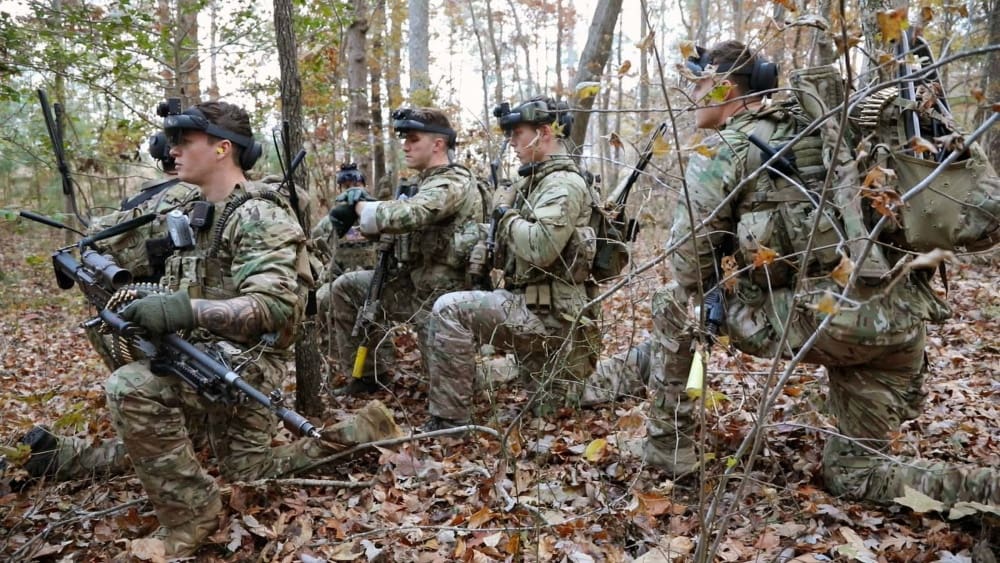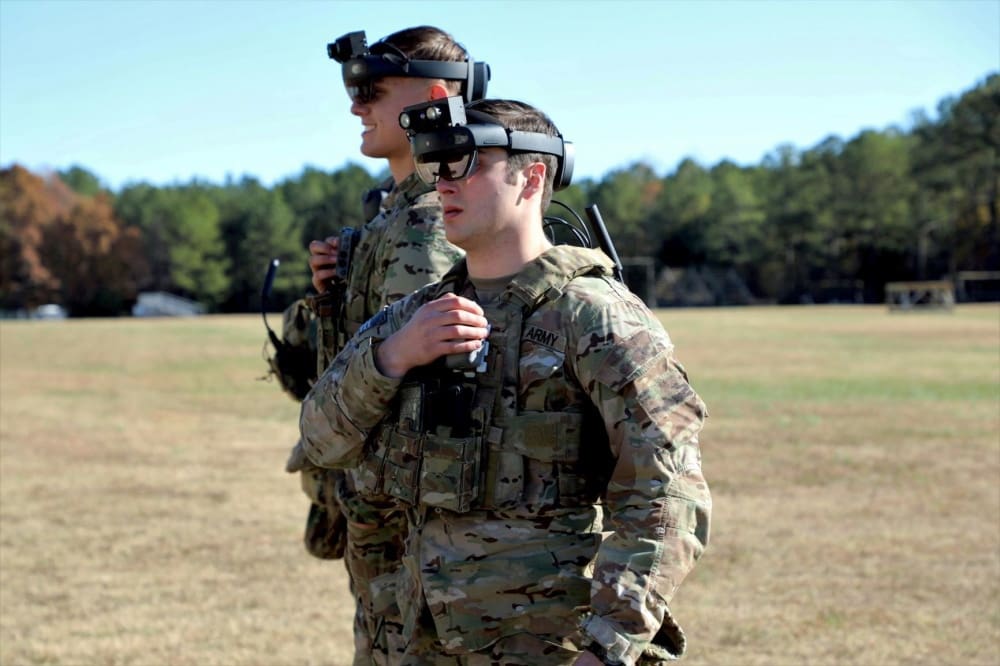Here one of the latest photos of the US Army’s Integrated Visual Augmentation System, a which fuses image intensification and thermal imaging with Augmented Reality overlays. It’s built by Microsoft.

Interestingly, the form factor is pretty similar to the Soldier Integrated Protective Ensemble headborne subsystem from the early 90s.

Here’s an update from the Program Office.
– COL. Chris Schneider, PM IVAS
FORT BELVOIR, Va.– Cutting-edge modernization efforts come with their own set of challenges, and COVID-19 has ensured that there are no exceptions.
Program Executive Office (PEO) Soldier’s Project Manager Integrated Visual Augmentation System (PM IVAS) continues to leverage the team’s unique structure, talents, and culture to contribute to the force’s readiness, even with the additional challenges presented by COVID-19.

Mark Stephens, PM IVAS Director of Acquisition and Operations, and Jared Walega, PM IVAS Test Director, highlighted how problem solving, routine distributed work solutions, modular architecture design, Soldier Centered Design (SCD), and Supply Chain Risk Management (SCRM) have allowed the project flexibility during the COVID pandemic.
Stephens emphasized how Team IVAS has applied efficient problem-solving skills from the project’s inception.
“Senior defense officials recognized the erosion in close combat capabilities and saw an immediate need to ensure overmatch for our dismounted force,” said Stephens. “Congress recognized the requirement and reprogrammed funds to start IVAS in FY19. Within six months from the Secretary of Defense’s approval in late May, Team IVAS awarded multiple Other Transaction Agreements to industry and kicked off IVAS before Christmas 2018.”
Team IVAS has rapidly solved problems ever since. This includes the successful integration of partners from around the country. Because the team overcame this initial obstacle, remote work is now routine.
The distributed team has built and relied on a digital infrastructure to manage the mission from any physical location. Therefore, they are able to maintain the mission even with the obstacles COVID has presented.
“When COVID hit we had already established a solid Integrated Product Team [IPT] Battle Rhythm using long distance collaboration methods like SharePoint, TEAMs, and Power BI,” Stephens said. “Using TEAMs over the past 18 months allowed video teleconferencing, sharing document collaboration, and reviewing our program management dashboards, so all our leaders were battle tested”.
Secure remote tools have allowed for continued IVAS prototyping through Army Enabled Tests (AET) even while team members are quarantined at home.
“We also implemented a practice of what we call Army Enabled Testing that allows us to get updates from our partners, test the updates in a safe environment, and provide feedback. This methodology helps us manage our performance risks, and not have to wait until Soldier Touchpoint 3 [STP 3] to discover problems,” said Stephens.
Team IVAS’ dynamic problem solving and reliable remote infrastructure guaranteed that aspects of testing continued to ensure minimal overall impacts to the program’s timeline.
“As COVID-19 impacted the organization, the Test Directorate determined we could still conduct a thorough AET with focus on Rapid Target Acquisition (RTA), Tactical Assault Kit (TAK), Synthetic Training Environment (STE), and other necessary capabilities while maintaining requisite social distance and implementing COVID-approved decontamination procedures for the Heads Up Displays (HUD),” said Walega.

“We have a dispersed team that is capable of downloading the latest software build and loading it onto their HUDs. This process has enabled remote testing of software builds and the ability to provide rapid feedback to Microsoft to include live fire video, data, and assessments,” Walega added.
The continued AET testing and iteration of specific IVAS capabilities through the COVID pandemic has been largely based on the Soldier feedback collected at every stage in development over the last 18 months.
“Soldier Centered Design (SCD) was developed in IVAS as a combination of Human Centered Design and tailored acquisition best practices,” said Walega. “SCD focuses on current Soldier and Marine input throughout the entire development process to prevent engineers and developers from building a product that does not meet the priorities of our warfighters.”
The process puts emphasis on making a product that Soldiers will enjoy using to increase their lethality in training and on the battlefield.
According to Walega, “If a Soldier loves and uses IVAS, then we have provided a system that has much greater capability than the current kit.”
In order to ensure that IVAS will truly maximize Soldier lethality, intentional Soldier feedback at every design and decision point has been a program priority.
“We have collected over 23,000 hours of Soldier feedback,” said COL. Christopher Schneider, Program Manager IVAS. “Because we’ve got so much feedback, we’re highly confident in the current design and STP 3.”
The Soldier-centric approach has turned out to be a key asset to the program during the change in normal operations. Though large scale events such as the IVAS STP 3 will shift due to COVID restrictions, the team has reorganized the internal program schedule so that IVAS is not delayed in deploying to the warfighter.
The team is reordering the intensive hardware and software design reviews that were initially planned for after STP 3, and is leveraging their ingenuity, remote tool infrastructure, and plethora of Soldier feedback to expedite the hardware design review to before the October event. This will allow the formal software design sprint to be completed after STP 3, and both designs to be finalized during Capability Set 4 iterations.
“We wouldn’t have the flexibility that we do, frankly, if we hadn’t been doing Soldier Touchpoints, user juries, user studies, and human factors engineering excursions throughout the last 18 months of the program,” said Schneider.
Though the pandemic has impacted every aspect of the program, including supply chain logistics, industry partners have continued to support with solutions.
“With the advent of the Coronavirus, the supply chain risk management strategy has taken on a new level of importance,” said Nicholas Pate, PM IVAS Manufacturing Engineer.
“IVAS vendors have worked tirelessly to assess, analyze, and make quick decisions to avert imminent delays. Luckily, the PM IVAS supply chain strategy, from the very start of the program, has always been to mitigate risk by avoiding sole sources of supply, cultivating multiple sensor vendors, and ensuring parallel paths of supply,” said Pate.
To date, IVAS vendors have been able to react quickly to minimize negative impacts from the Coronavirus.
“Microsoft, as well as the low light and thermal sensor vendors, delivered preliminary supply chain information on critical components for early risk mitigation assessment on the IVAS supply chain,” Pate added. “This information ensures that quality and security controls are implemented to ensure a stable and sustainable supply chain.”
As Team IVAS continues to overcome COVID’s obstacles, leadership is unwavering in its dedication to the safety of both Soldiers and the team.
“We really took a deliberate thought process and approach to moving the Soldier Touchpoint into October,” said Schneider. “We wanted to make sure that we had the opportunity to get it right.”
Overall, every decision has been made with the safety of the team and readiness of Soldiers as top priorities. Though STP 3 is now taking place in October at Fort Pickett, Va., the rest of the program deliverables remain on track.
“I can absolutely say that today we are on track to meet a fourth quarter ‘21 delivery for our first unit equipped,” said Schneider.
Story by Courtney Bacon.


Very interesting and definitely one of the key areas for soldier R&D. It would be good to build this capability on a basic soldier who is trained and equipped to reliably kill targets from 0-800m (bare hands to rifle), use a compass and map, communicate, operate in all terrain/weather conditions, cover 30-40k a day on foot carrying combat load, etc. and maybe most of all possess the fingerspitzengefühl and processor speed to win. Not sniping at the IVAS effort in any way here: it’s essential. However, as we sprint to the next step, the AI-enabled force, etc., there will be some stumbles and things will not go as planned (Murphy seems to easily keep pace with new tech) and the basics need to be there.
Time and budget realities kick in and the grueling “old school” field training seems to be the first thing shitcanned.
Recent events in Galwan Valley/Ladakh/Aksai Chin (fascinating history worth looking into there) prove stone age skills matter….and also a rare operational glimpse of “peer”/near-peer (maybe just call them nuclear-equipped to make it easy to understand the stakes) forces in conflict. Thanks to SSD for providing an easy to digest, damned near 24/7/365 report on equipment and developments in R&D.
Since I had to look it up, I figure others might as well:
Fingerspitzengefühl [?f?????p?ts?n???fy?l] is a German term, literally meaning “finger tips feeling” and meaning intuitive flair or instinct, which has been adopted by the English language as a loanword. It describes a great situational awareness, and the ability to respond most appropriately and tactfully. It can also be applied to diplomats, bearers of bad news, or to describe a superior ability to respond to an escalated situation.
Literally the most exciting thing the army is working on right now. I do foresee them hitting a “iPhone 1 moment” Where you have this super capable device but not have the required network throughput to leverage it to anywhere near it’s full capabilities. Hats of to the PEO shop and hats off to Microsoft for making hololens wich is the backbone of this system.
I don’t think network throughput will be the problem, if you look at some of the new systems like the AN/PRC-163 and other possible systems like Starlink’s high data rate satcom, communications tech isn’t the problem, it’s more the electronic warfare that might choke some applications. That being said, I think the biggest problem with it will be that, like the iPhone 1, there won’t be too many good applications that are 100 percent reliable. even after this system is developed there will need to be years worth of R&D on the application and device-based artificial intelligence side. I’m definitely not knocking the system, I think it’s more than capable and i’m excited to see what comes out of it, especially since I may end up using it.
“if you look at some of the new systems like the AN/PRC-163…” You must be reading Harris’s spec sheets and not talking to the people actually using it in field trials.
That being said – yes, movement to battlefield MANETs, LTE and similar will provide a significant increase in wideband networking at the true tactical edge (not a static BN FOB). The other significant issue that has to be addressed is end user training. From what I’ve seen, we’re at this paradigm right now where industry can deliver iPhone-whatever level technology, but the bulk of our force is only capable of using a jitterbug when it comes to tactical radios. The line between RF and Networking is closer and closer every day… commo guys need to be well versed in both, among others. Imagine taking this 163 to the crypto guy who’s the only guy who knows how to fill it or configure the crypto, then to the satcom guys who are the only ones who understand how those links work, then to the VULOS guy who programs those freqs and tells you about antennas, and then the networking guy who does all of the MANET config and IP scheme.
Does a rifleman have to take his or her M4 to the laser person to dial it in and then to the optics guy to zero the optic, and then to the maintenance guy every time they need to conduct SPORTS/POPS, etc.? No, because we’ve adequately trained all of those as individual tasks associated with the weapon. The problem with commo is that training generally consists of putting a battery on, screwing an antenna on, hooking up a mic/earpro and then changing a channel and pressing a button. We haven’t approached comms in the same holistic way we approach weapons training. And this is why you see riflemen running around with the “smallest antenna that’s been bent and rubber-banded and tucked in every possible direction other than it’s polarization and wondering “why their comms suck.”
TL;DR Yes – this technology is awesome, but I hope we collectively do not put too much effort in making it “so easy and intuitive” that the end user has no idea what’s actually going on with the item and therefore cannot draw informed conclusions when A or B isn’t working.
This x 1000 ^^^
I completely agree with you, also i’m not praising the 163, your average soldier won’t be using most of it’s capabilities even with the IVAS, and there is no way that there are going to be true high capacity manets on the battlefield anytime soon.
I highly doubt that the IVAS is going to require a high speed networking radio to take advantage of most of it’s features, as it’s probably going to be using onboard apps 90% of the time.
In terms of radio training I completely agree with you, given all of the current electronic warfare threats it is completely necessary. It probably wouldn’t be down to jitterbug level, but training soldiers on a common radio management software / app and giving a 101 on everything would help deal with troubleshooting and setup.
It definitely wouldn’t be a fix all, and there would still be those individual comms/networking/crypto guys, but it would help bring your average joe’s radio competency up to the point that they don’t have to rely on them.
IVAS probably won’t need too powerful of a network to be effective, and comms training needs updated either way you look at it.
just another Land warrior system, destined for cancellation. It’s funny that Google had a heads-up display literally 1/10 of the weight 7 years ago
The way this is actually going to happen is when smart glasses hit consumer mainstream and Samsung comes out with a military version, just like their military smartphones they’re just starting to produce.
Throwing these to a huge military contractor is just wasteful pork spending and only produces proof-of-concept prototypes.
So, a PVS21 with the thermal overlay module, and display integration.
What’s so new about that?
This steps away from image intensification and only has digital cameras. Also this has roughly the same field of view as the GPNVG. Additionally it has an integrated computer and sensors, so it can show a marker or waypoint in your view in real time, which the PVS21 can’t do, since the display integration is only a simple screen.
Goal is augmented reality, not just thermal overlay. Full HUD functionality.